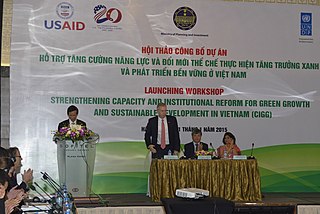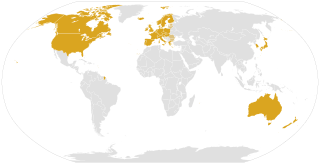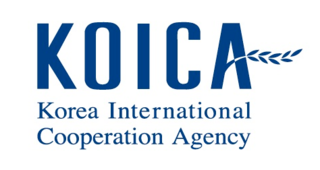Related Research Articles

The Millennium Development Goals (MDGs) were eight international development goals for the year 2015 that had been established following the Millennium Summit of the United Nations in 2000, following the adoption of the United Nations Millennium Declaration. These were based on the OECD DAC International Development Goals agreed by Development Ministers in the "Shaping the 21st Century Strategy". The Sustainable Development Goals (SDGs) succeeded the MDGs in 2016.
Official development assistance (ODA) is a category used by the Development Assistance Committee (DAC) of the Organisation for Economic Co-operation and Development (OECD) to measure foreign aid. The DAC first adopted the concept in 1969. It is widely used as an indicator of international aid flow. It refers to material resources given by the governments of richer countries to promote the economic development of poorer countries and the welfare of their people. The donor government agency may disburse such resources to the government of the recipient country or through other organisations. Most ODA is in the form of grants, but some is measured as the concessional value in soft (low-interest) loans.
Aid effectiveness is the degree of success or failure of international aid. Concern with aid effectiveness might be at a high level of generality, or it might be more detailed.

Capacity building is the improvement in an individual or organization's facility "to produce, perform or deploy". The terms "capacity building" and "capacity development" have often been used interchangeably, although a publication by OECD-DAC stated in 2006 that "capacity development" was the preferable term. Since the 1950s, international organizations, governments, Non-Governmental Organizations (NGOs) and communities use the concept of capacity building as part of "social and economic development" in national and subnational plans. The United Nations system defines itself by "capacity development;" as the "how" for "'how UNDP works" to fulfill its mission The UN system applies it in almost every sector, including now several of the Sustainable Development Goals. For example, the United Nations Sustainable Development Goal 17 advocates for enhanced international support for capacity building in developing countries to support national plans to implement the 2030 Agenda.

The European Development Fund (EDF) is the main instrument for European Union (EU) aid for development cooperation in Africa, the Caribbean, and Pacific countries and the Overseas Countries and Territories (OCT). Funding is provided by voluntary donations by EU member states. Until 2020 the EDF was subject to its own financial rules and procedures, and was managed by the European Commission (EC) and the European Investment Bank. The EDF has been incorporated into the EU's general budget as of the 2021-2027 multi-annual financial framework.

The Organisation for Economic Co-operation and Development's (OECD) Development Assistance Committee (DAC) is a forum to discuss issues surrounding aid, development and poverty reduction in developing countries. It describes itself as being the "venue and voice" of the world's major donor countries.
The first Cambodia Development Cooperation Forum (CDCF), a restructured format for the Consultative Group (CG) meeting, was held in Phnom Penh on June 19–20, 2007. The CDCF was chaired by the Royal Government of Cambodia (RGC) with the World Bank as the Lead Donor Facilitator. The theme for 2007 was "Progress in Implementing the National Strategic Development Plan 2006-2010".

The United Nations Department of Economic and Social Affairs is part of the United Nations Secretariat and is responsible for the follow-up to major United Nations Summits and Conferences, as well as services to the United Nations Economic and Social Council and the Second and Third Committees of the United Nations General Assembly. UN DESA assists countries around the world in agenda-setting and decision-making with the goal of meeting their economic, social and environmental challenges. It supports international cooperation to promote sustainable development for all, having as a foundation the 2030 Agenda for Sustainable Development and the 17 Sustainable Development Goals (SDGs) as adopted by the UN General Assembly on 25 September 2015. In providing a broad range of analytical products, policy advice, and technical assistance, UN DESA effectively translates global commitments in the economic, social and environmental spheres into national policies and actions and continues to play a key role in monitoring progress towards internationally agreed-upon development goals. It is also a member of the United Nations Development Group.
The International Health Partnership (IHP+) is a group of partners committed to improving the health of citizens in developing countries. International organizations, bilateral agencies and country governments all sign the IHP+ Global Compact. They commit to putting the principles for aid effectiveness and development cooperation into practice in the health sector. IHP+ achieves results by mobilizing national governments, development agencies, civil society and others to support a single, country-led national health strategy. Partners aim to hold one another to account. This global initiative is administered by the World Health Organization and the World Bank.

The Korea International Cooperation Agency was established in 1991 by the Ministry of Foreign Affairs of South Korea as a governmental organization for Official Development Assistance (ODA) to enhance the effectiveness of South Korea's grant aid programs for developing countries by implementing the government's grant aid and technical cooperation programs. It is led by three-year-term president of the board who is appointed by the President upon the recommendation of Foreign Minister.
Wikiprogress is a defunct online platform for sharing information on the measurement of social, economic and environmental progress. It is thought to facilitate sharing on ideas, initiatives and knowledge on "measuring the progress of societies". Like Wikipedia, it was open to all members and communities for contribution – anyone interested in "progress" could register.

The Organisation for Economic Co-operation and Development is an intergovernmental economic organisation with 38 member countries, founded in 1961 to stimulate economic progress and world trade. It is a forum of countries describing themselves as committed to democracy and the market economy, providing a platform to compare policy experiences, seek answers to common problems, identify good practices and coordinate domestic and international policies of its members. Generally, with the exception of Mexico and Colombia, OECD members are high-income economies with a very high Human Development Index (HDI) and are regarded as developed countries. As of 2017, the OECD member countries collectively comprised 62.2 % of global nominal GDP and 42.8 % of global GDP at purchasing power parity. The OECD is an official United Nations observer.
The Enhanced Integrated Framework for Trade-Related Assistance for the Least Developed Countries is a global development program with the objective of supporting least developed countries (LDCs) to better integrate into the global trading system and to make trade a driver for development. The multi-donor program was launched on 1 January 2007 as the successor of the Integrated Framework for Trade-Related Technical Assistance to the Least-Developed Countries, which existed from October 1997 to December 2006. The second phase of the EIF has started on 1 January 2016 and will last for 7 years.
The Open Forum for CSO Development Effectiveness was the medium for a process led by civil society organizations (CSOs), between 2008 and 2012, to agree common principles and guidelines on CSO development effectiveness and bring the collective vision of organized people's groups into international development policy and practice.

The Sustainable Development Goals (SDGs) or Global Goals are a collection of 17 interlinked global goals designed to be a "blueprint to achieve a better and more sustainable future for all". The SDGs were set up in 2015 by the United Nations General Assembly and are intended to be achieved by the year 2030. They are included in a UN Resolution called the 2030 Agenda or what is colloquially known as Agenda 2030. The SDGs were developed in the Post-2015 Development Agenda as the future global development framework to succeed the Millennium Development Goals which ended in 2015.
Goodbye Conflict, Welcome Development The g7+, established in 2010, is an intergovernmental voluntary organisation bringing together countries that are either facing active conflict or have recent experience of conflict and fragility. It has 20 member countries from Asia, the Pacific, Africa and the Caribbean with a combined population of 260 million.

Policy coherence for development (PCD) is an approach and policy tool for integrating the economic, social, environmental and governance dimensions of sustainable development at all stages of domestic and international policy making. It is the aim of Policy Coherence for Development to make foreign relations to be as ecologically, economically and socially coherent as possible and thereby to make international co-operation for international development more effective.
Four high level forums on aid effectiveness were held between 2003 and 2011 as part of a "continuous effort towards modernising, deepening and broadening development co-operation and the delivery of aid" coordinated through the OECD. They took place at Rome (2003), Paris (2005), Accra (2008) and Busan (2011).

Sustainable Development Goal 17 is about "partnerships for the goals." One of the 17 Sustainable Development Goals established by the United Nations in 2015, the official wording is: "Strengthen the means of implementation and revitalize the global partnership for sustainable development". The Goal has 17 targets to be achieved by 2030, broken down into five categories: finance, technology, capacity building, trade and systemic issues. Progress towards targets will be measured by 25 indicators.

Sustainable Development Goals and Nigeria is about how Nigeria is implementing the Sustainable Development Goals within the thirty-six states and its Federal Capital Territory (FCT), Abuja. The Sustainable Development Goals (SDGs) consist of seventeen global goals designed as a "blueprint to achieve a better and more sustainable future for all". Each of the 17 goals is expected to be achieved by 2030 in every country around the world.
References
- 1 2 "Busan High Level Forum on Aid Effectiveness: Proceedings" (PDF). OECD. 2011. pp. 17–28. Retrieved 2021-04-21.
- 1 2 3 "The Global Partnership at a glance" (PDF). GPEDC. Retrieved 2021-06-11.
- ↑ "Meet the leadership". GPEDC. Retrieved 2021-06-11.
- 1 2 3 "Nairobi Outcome Document" (PDF). GPEDC. 2016-12-01. Retrieved 2021-06-11.
- 1 2 "Busan Partnership for Effective Development Cooperation" (PDF). Global Partnership for Effective Development Cooperation. 2011. Retrieved 2021-04-28.
- 1 2 3 4 5 Abdel-Malek, Talaat (2015). The global partnership for effective development cooperation: origins, actions and future prospects (PDF). Bonn. ISBN 978-3-88985-668-5. OCLC 919451052.
- 1 2 Tran, Mark (2013-08-15). "Apathy over aid effectiveness threatens global partnership". The Guardian. Retrieved 2021-04-28.
- ↑ "Mexico High Level Meeting Communiqué, 16 April 2014". Global Partnership for Effective Development Cooperation. Retrieved 2021-04-29.
- 1 2 3 4 Glennie, Jonathan (2014-04-22). "Development partnership conference: what did we learn?". The Guardian . Retrieved 2021-04-28.
- ↑ Johnsson, Anders B. (2014-04-14). "Opening Remarks by the IPU Secretary General, Parliamentary Meeting on the Occasion on the First High-Level Meeting of the GPEDC" (PDF). Inter-Parliamentary Union. Retrieved 2021-04-29.
- ↑ Craviotto, Nerea (2014-04-24). "Global Partnership for Effective Development Cooperation: A feminist perspective following the First High Level Ministerial Meeting". Association for Women's Rights in Development . Retrieved 2021-04-29.
- ↑ Source: "Making development co-operation more effective: 2016 progress report". OECD. 2016. Retrieved 2021-06-12.
- 1 2 Klingebiel, Stephan; Xiaoyun, Li (2016-12-07). "Crisis or progress? The Global Partnership for Effective Development Cooperation (GPEDC) after Nairobi". d.i.e - Deutsches Institut für Entwicklungspolitik. Retrieved 2021-05-03.
- 1 2 Bena, Farida T. (January 2017). "The outcome of the 2nd High Level Meeting of the Global Partnership for Effective Development Co-operation and why it matters" (PDF). Aidwatch Canada. Retrieved 2021-06-12.
- 1 2 Bracho, Gerardo (2017). "The troubled relationship of the emerging powers and the effective development cooperation agenda: history, challenges and opportunities" (PDF). Deutsches Institut für Entwicklungspolitik (DIE), Bonn. Retrieved 2021-06-12.
- 1 2 3 "Making development co-operation more effective: 2019 progress report" (PDF). GPEDC. 2019. Retrieved 2021-06-11.
- 1 2 "Co-chairs statement, Senior level meeting of the Global Partnership for Effective Development Co-operation" (PDF). GPEDC. Retrieved 2021-06-11.
- ↑ "Making Development Co-operation More Effective, 2019 Progress Report - GPEDC". www.oecd.org. Retrieved 2020-05-20.
- ↑ "How we partner together for sustainable development: 2020-2022 work programme" (PDF). GPEDC. May 2020. Retrieved 2021-06-12.